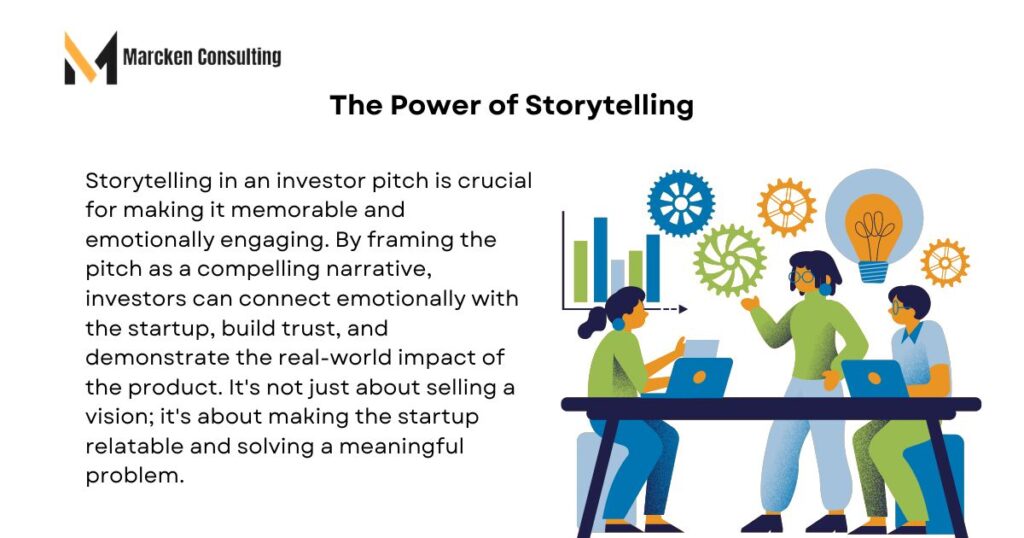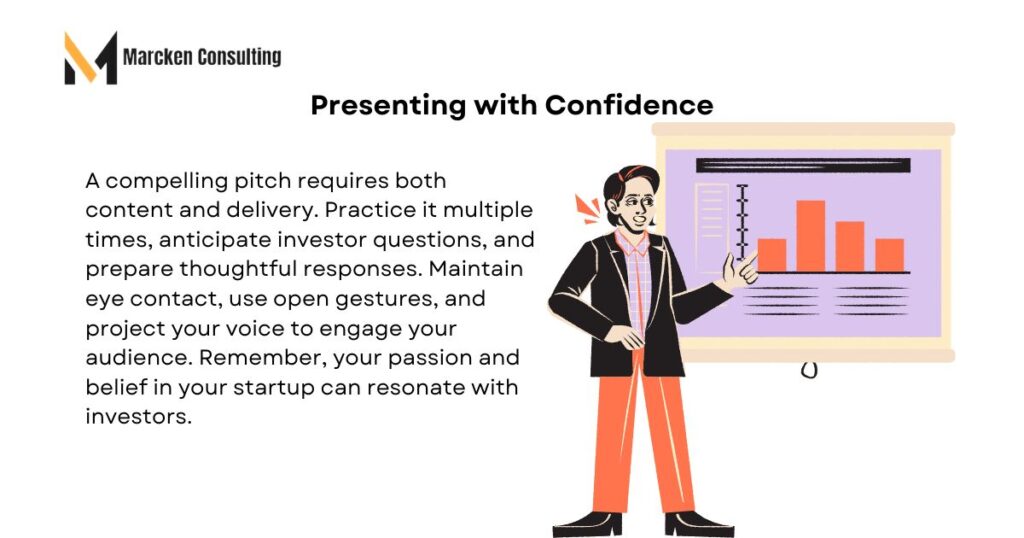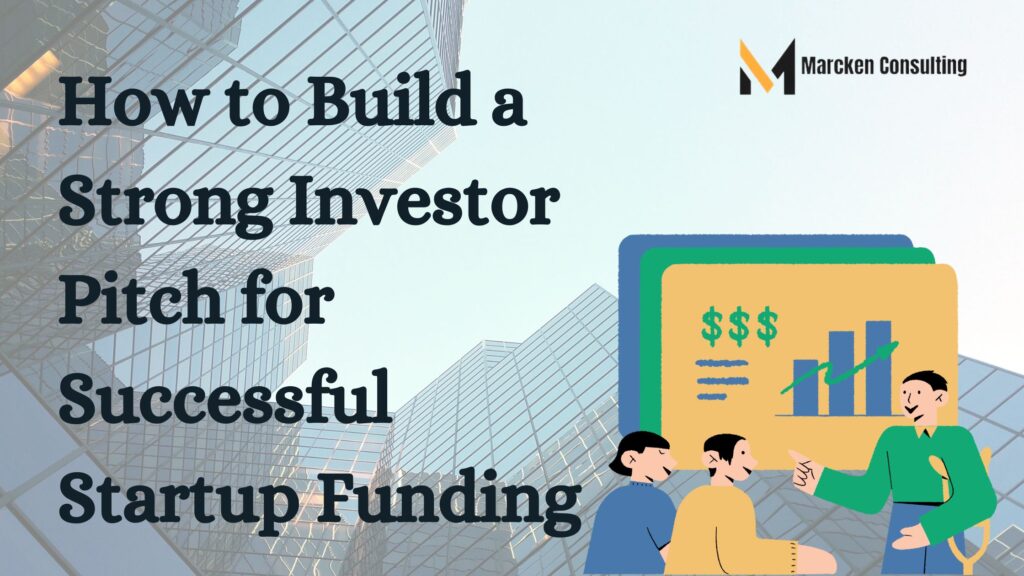Securing startup funding is no easy task, but a strong investor pitch can dramatically increase your chances of success. Whether you’re approaching venture capitalists, angel investors, or private equity firms, the key lies in how well you present your business idea, its potential, and your financial needs. A strong pitch combines strategy, storytelling, and quantitative data to persuade potential investors that your firm is worth their money.
At Marcken Consulting, we understand the challenges startups face in this crucial phase. That’s why we help businesses build powerful, compelling pitch decks that capture investor attention and showcase your startup’s growth potential. Whether you need support with Pitch Decks, Funding Strategies, or creating detailed Valuation Reports, our team guides you at every step of your fundraising journey.
In this blog, we will walk you through the key components of a winning investor pitch, common mistakes to avoid, and how you can confidently present your startup to secure the funding you need.
Table of Contents
Toggle1. Understand Your Audience
Before you even start crafting your investor pitch, it’s crucial to understand who you’re pitching to. Different types of investors—whether they’re angel investors, venture capitalists, or private equity firms—have varying priorities, risk appetites, and expectations. Tailoring your pitch to the specific type of investor you’re targeting can significantly boost your chances of securing funding.
For instance, angel investors typically look for high-growth potential and are more likely to invest in early-stage startups with promising ideas but limited traction. On the other hand, venture capitalists focus on scalability and a clear path to profitability, often seeking businesses that have already demonstrated some level of traction, whether it’s in the form of revenue, user base, or market share. Private equity firms, on the other hand, may be interested in more established businesses with strong fundamentals and opportunities for significant growth.

Researching the investors you’re targeting allows you to highlight the aspects of your business that will resonate most with them. By aligning your pitch with their goals—whether it’s quick returns, long-term growth, or high-risk innovation—you demonstrate that you understand their perspective and are offering them an opportunity that fits their investment strategy.
For more insights into how different types of investors evaluate startups, check out our detailed blog on Venture Capital Funding for SMEs or explore how Private Equity Funding can help scale your business.
2. Key Components of a Strong Investor Pitch
A well-structured investor pitch includes several essential elements that showcase your startup’s potential and convince investors of its worth. Here’s a breakdown of the key components that should be in every strong pitch:
(i) Problem Statement
Outline the problem your business seeks to answer in detail first. Investors need to understand the pain point you’re addressing and why it matters The more precise you are about the problem’s size and impact, the better you can demonstrate your market opportunity. A well-defined problem also positions your solution as a critical and timely intervention.
(ii) Solution/Product
After laying out the problem, introduce your solution. Explain how your product or service addresses the issue uniquely and innovatively. Keep it simple and focus on the core value your solution brings to customers. Highlight any differentiating features that give you a competitive edge in the market.
(iii) Market Opportunity
Next, demonstrate the size and potential of your market. Investors want to know that you’re operating in a growing market with room for expansion. Include statistics, research, and forecasts to back up your claims. Describe your target market in detail and provide evidence of a sizable market for your product. For further insight, see our blog on Business Valuation in India: Understanding Regulations & Exploring Case Studies, which covers how market potential affects valuation.
(iv) Business Model
A clear and effective business model shows how your startup plans to make money. Investors are interested in your revenue streams, pricing strategy, and scalability. Outline how your business operates, from customer acquisition to monetization, and provide evidence of how this model can grow over time.
(v) Traction
Showcase your progress to date. Traction refers to any signs that your business idea is working in the real world, such as early sales, user growth, partnerships, or product development milestones. Investors are more confident in your ability to execute when you have traction, which is evidence that you’re headed in the correct path.
(vi) Financial Projections
Provide realistic financial forecasts that show your path to profitability. Investors are looking for data that supports future growth. Add projected income, expense breakdowns, and profit margins. Don’t forget to be conservative and grounded in reality to maintain credibility.
(vii) Funding Ask
Finally, be clear and specific about how much funding you’re seeking and how it will be used. Break down your budget and explain exactly where the funds will go—whether it’s product development, marketing, or scaling operations. This transparency shows that you’re thoughtful and strategic in your financial planning.
Each of these components plays a critical role in building a pitch that resonates with investors, giving them the information and confidence they need to consider backing your startup.
3. The Power of Storytelling
While facts and figures are essential in an investor pitch, storytelling can make your presentation truly memorable. Investors are more likely to connect emotionally with your startup if you frame your pitch as a compelling narrative. Begin by painting a picture of the problem, then walk them through the journey of how your solution addresses it. By weaving data and real-world examples into your story, you can build trust and show the real-world impact of your product.
Storytelling is not just about selling a vision—it’s about making your startup relatable and showing that it solves a meaningful problem. For more on using data to back your story, check out our guide on DCF Valuation for Early-Stage Startups, which helps anchor your narrative in solid financial projections.

4. What Investors Want to See
Investors are primarily interested in how your startup can scale, generate returns, and create long-term value. Here are the key elements they focus on during a pitch:
(I) Scalability
Investors want to know that your business can grow rapidly without a proportionate increase in costs. Highlight your ability to reach a large target market and scale efficiently.
(II) Path to Profitability
Your financial projections should clearly show how your business will become profitable over time. Investors look for realistic growth models, so be sure to provide data-driven forecasts and explain your assumptions.
(III) Competitive Advantage
Demonstrating how your startup stands out in the market is crucial. Whether it’s through innovation, a unique business model, or intellectual property, investors want to see a sustainable edge over competitors.
(IV) Strong Team
A talented, experienced, and driven team reassures investors that your startup is in good hands. Highlight essential personnel and their relevant experience.
5. Common Mistakes to Avoid
Even the most innovative startups can stumble during an investor pitch by making avoidable mistakes. The following are some typical mistakes to be aware of:
- Overly Technical Jargon: Keep your pitch simple and avoid getting lost in complex terminology. Investors may not be experts in your field, so clarity is key.
- Unrealistic Financial Projections: Inflated numbers can harm your credibility. Stick to data-driven, conservative forecasts that reflect market realities.
- Ignoring Risks and Challenges: Investors know that every startup faces risks. Acknowledge potential challenges and show you have strategies to address them.
- Unclear Funding Ask: Be precise about how much you’re raising and how the funds will be used. Ambiguity in your financial ask can lead to confusion and missed opportunities.
For a deeper look at common errors made during valuation, visit our blog on Top 5 Mistakes Entrepreneurs Make While Valuating Their Startups.
6. Presenting with Confidence
A compelling pitch not only relies on content but also delivery. To present with confidence, practice your pitch multiple times until you’re comfortable with the flow and content. Anticipate questions from investors and prepare thoughtful responses. Body language matters—maintain eye contact, use open gestures, and project your voice to engage your audience. Remember, your passion and belief in your startup can resonate strongly with investors. If you need help refining your pitch or preparing for investor meetings, consider exploring Marcken Consulting’s Business Consulting services.

Conclusion
To sum up, creating an effective investor pitch is crucial to getting money and accelerating the expansion of your business. You may craft an engaging story that appeals to investors by knowing your audience, including essential elements, and avoiding typical mistakes. Remember, confidence in your presentation can significantly impact how your pitch is received. If you’re looking for expert guidance to refine your pitch or navigate the funding landscape, explore Marcken Consulting’s services for Funding Support and Valuation Reports to enhance your chances of success.
Frequently Asked Questions
Q1.Why is understanding my audience important when pitching to investors?
Tailoring your pitch to the specific interests of investors increases your chances of success. Different investors focus on different aspects of a business, so aligning your pitch with their needs is crucial.
Q2. What are the key elements of a pitch to investors?
Key elements include a clear problem, unique solution, market opportunity, business model, traction, financial projections, and a specific funding ask.
Q3. What mistakes should I avoid in my pitch?
Avoid technical jargon, inflated projections, ignoring risks, and unclear funding requests. These can harm your credibility.


